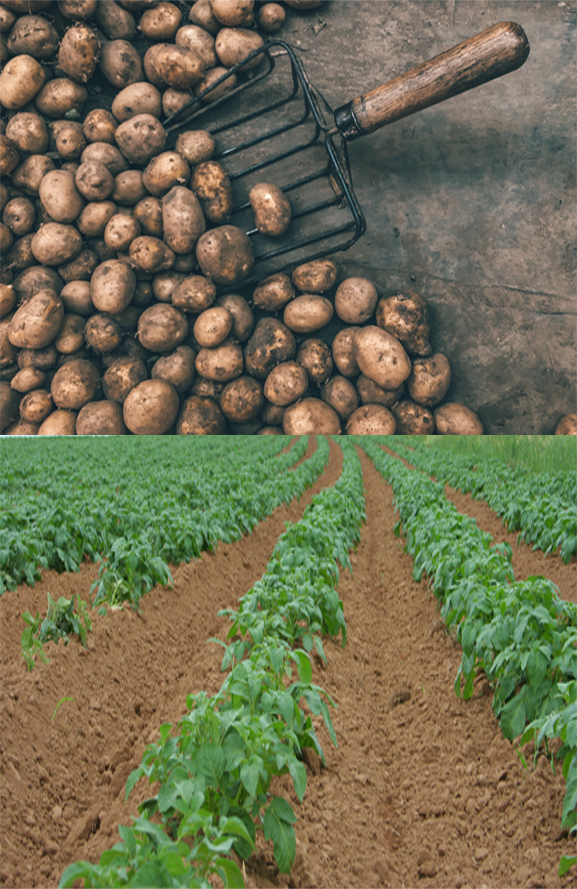Growing organic potatoes in your backyard need to take few cautious attention while soil preparation, selecting early producing disease resistant potato varieties with the usage of natural fertilizers, row covers, crop rotation and if needed, the careful applications of organic pesticides for the growth of your garden.
Organic potatoes can be grown without pesticides or synthetic fertilizers. Potatoes can be grown neither in cool weather or freeze nor above 80 degree Fahrenheit which decrease tubular production. Early producing varieties can give a good crop before enhance the diseases and insects. Best varieties to start with include Irish Cobbler, Red Duke of York, Norland, Orla, and Yukon Gold.

Site and soil
In the area where the sunlight can falls at least six to eight hours in that potatoes should be grown with a basic fertility and well drained. Planting plants in well drained soil rich in organic matter can avoid few diseases such as green manure are sown earlier in autumn, sowed in the field before sowing, or composted during sowing.
In acidic soil potatoes can grow well and not easy to get sick. Soil can be more acidic due to natural sulphur. To know your soil pH test contact your county extension office (ceo).
Potato plant needs fertilizers but not too much which cause leggy, disease prone growth. Add basic required amount of compost, or while planting dig in a small amount of natural fertilizer or organic poultry manure. After planting, second application of fertilizer can improve yields.
Full size tubers can be difficult to form heavy clay soil. It should be the spot where from past 2 years there is no crop of potatoes, pepper, tomatoes and eggplants to prevent the soil borne diseases.
Planting
Early season varieties can be planted as soon as soil can be worked when its temperature reaches 40 degree Fahrenheit. Mid and late season varieties can be planted before the last weeks of late spring frost. You can plant only those seed potatoes which are certified disease free. These are available in garden centres, nurseries, and catalogs.
For early potatoes, laying your tubers eye side up in a cool and dry place in a container for 1 to 2 weeks, until the eyes sprout. Just plant the tubers whenever you’re ready. The larger potatoes can be cut in the form of 1 to 3 eyes per piece and for smaller potatoes can be planted whole. Be sure that the cut pieces of potatoes can be place outside for at least 24 hours before planting due to that cut sides callous over and they don’t rot.
Also Read: Potato Farming Techniques
There many methods for planting potatoes in your garden
Planting in trenches: cultivate a trench of about 7 to 8 inch and place the potato in 12 inches apart and cover with four inches of soil.
Planting in individual planting holes: drill a hole of about 7 to 8 inch deep and wide, keep the potatoes in a hole cover them with four inches soil.
In containers place the six inches of soil mix them in a bottom, keep the potatoes in an upper layer of the container and cover with a four inches of soil.
Growing potatoes
Potatoes can be grown in your garden is very easy and it needs one inch of water per week. You have to hill your potatoes regularly to keep that area watered and weed free. If you’re altering your soil with compost, won’t require fertilizers. If you’re not amended the soil with fertilizer then use organic fertilizer while planting time and follow the instructions of the product how to use. When the foliage of your soil reaches 12 inches then add soil to the top of the trench or hole leaving behind 4 inches of foliage exposed. You have to do this for every couple of weeks.
Pests and diseases
Few common diseases and pests for potatoes are including:
Colorado potato beetle: larvae, handpick beetles, and eggs from plants
Flea beetles: make the area weed-free so you don’t provide cover for flea beetles, spray with insecticidal soap
Leafhoppers: burst with water from the hose
Aphids: burst with water from the hose
Scab: plant resistant varieties, crop rotation
Late Blight: clean up previous season’s foliage and tubers, plant resistant varieties, crop rotation
If you have above mentioned pests in your garden, it is preferable to cover your potatoes patch with a floating row cover to avoid problems.
Also Read: Growing Your Favorite Peanuts or Groundnuts
Harvesting
At any time of the year, as long as you see flowers on the plants, you can dig up young potatoes. If you are growing potatoes for storage, let the leaves turn brown. The best way to harvest potatoes is to use a digging pitchfork and start from the outer edge of a trench. Try to get the fork as deep into the soil and lift to collect potatoes as much as possible. You can save garden seed potatoes year after year, Just store healthy tubers in a cool, dry place.
The good news is that over time, you will end up with a variety of potatoes suitable for your garden environment. To store potatoes, store them in a dark, cool, but not frost-free place with little moisture. Do not wash them before storing, let them sit for a few minutes. A few days after harvest, allow the soil attached to the tubers to completely dry out.
Usually the one plant produces two to ten pounds of potatoes.
Also Read: Sweet Potato Farming Information Guide

